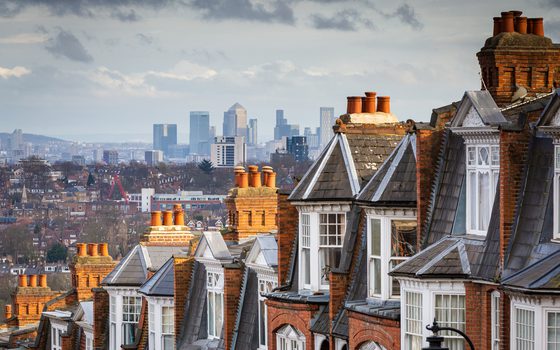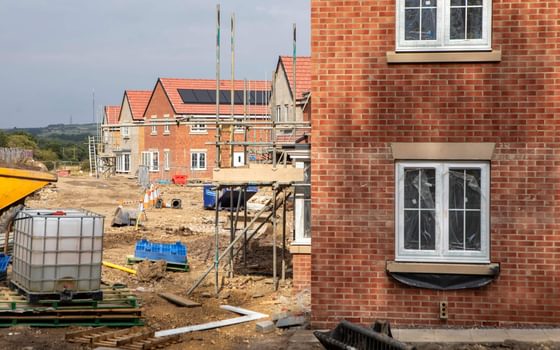A better way to tackle the housing crisis
How a universal basic services approach to housing could meet everyone's needs now and in the future
03 October 2025
“Build, baby, build!” is the government’s new housing mantra, courtesy of minister Steve Reed, seen around Labour conference in a MAGA-style baseball cap. He has announced construction of 12 new towns and issued a “call to arms” for developers and housebuilders. Barriers will be swept away, leaving ‘no stone unturned’ to build 1.5 million homes.
The underlying aim of putting “the key to a decent home into the hands of every single family that needs it” is of course welcome. But, while signalling a steely desire to get the job done is all well and good, we can’t build, baby, build without considering what it means for the planet.
In the UK, one fifth of carbon emissions come from residential buildings. The Climate Change Committee says we cannot meet our legally-binding climate change targets “without the near-complete elimination of greenhouse gas emissions from UK buildings” and there are vanishingly few signs of progress in that direction. Emissions from construction and demolition are dangerously high and rising, even before this massive new boom is unleashed. So what’s the cost to the planet of 12 new towns? Who benefits from “leaving no stone unturned” – all of us or just private developers?
There is a better way to tackle the housing crisis, with a growing body of evidence to support it. Today a report from NEF and the Social Guarantee, Good Green Homes For All, brings that evidence together to examine what it would take to deliver housing as a universal basic service (UBS). This is an eco-social approach with three goals. First, ensure universal access to life’s essentials, according to need, not ability to pay. Second, safeguard the natural environment, so that needs can be met for future as well as current generations. Third, foster collective action, through state and community-based organisations, because markets too often fail to deliver fairly, sustainably or at all.
From this starting point, the driving force behind housing policy is not to throw up as many new buildings as possible through headlong deals with the construction industry, but to do what it takes to meet everyone’s needs without wrecking our finite ecosystem. This calls for a whole-systems programme to deliver enough housing so that everyone can live comfortably, now and in future.
Central to the UBS vision is much more social housing, as NEF has argued elsewhere. However, according to recent analysis, there is more existing housing space that is empty or under-used (surplus to requirements) than there are people with unmet housing needs. A lot more. Taking public control of surplus properties, redirecting them to non-profit purposes, and reshaping and refurbishing them as necessary, would make a sizeable contribution to the stock of genuinely affordable, quality social housing.
Redistributing existing space is not a total fix, but it’s a good start. It could include ‘adaptive reuse’ of empty offices and retail properties, as well as measures to encourage under-occupiers and “empty-nesters” to downsize. It could speed up delivery. And it’s far more sustainable – both because surplus properties are found to have day-to-day emissions with “intensity far greater than the national average” and because the energy required for the process of refurbishment is considerably less than in demolition and construction. Win-win: social and environmental measures are friends, not foes.
That’s just part of the picture. Delivering housing as a universal basic service would also include policies to ensure that all existing homes are properly retrofitted, that all new homes are built to the highest standards for quality and sustainability, that everyone can find a home that is secure, energy-efficient and affordable, and that neighbourhoods are congenial, well-connected with transport links, and amply supplied with green spaces, public services and amenities. New social housing should be seen not as a last resort, but as “public luxury”: “an attractive proposition – safer and more broadly appealing than private renting or home ownership”.
Our report sets out a range of practical measures for realising these objectives. It recognises vested interests that lock-in the status quo – including the powerful lobbies for landlords, private developers and financiers, who have long treated housing as an asset to be accumulated for profit. If the government really does have a steely desire to get things done, it should shift its focus from cutting red tape to tackling the structural barriers that stand in the way of more affordable social housing.
Serious public funds are required to make this work. But as the report argues in some detail, investment would yield substantial social, environmental and economic benefits: a healthier society, improved living standards and reduced living costs, the prevention of harms that trigger demand for costly state interventions, more people in work, more low carbon jobs, a prosperous economy and a sustainable natural environment. In the end, it’s about building people’s lives, not just building buildings.
Image: iStock
Topics Housing & land






